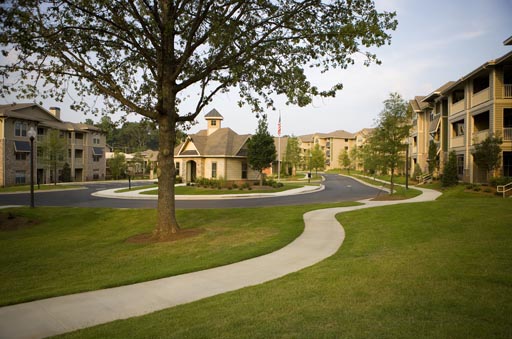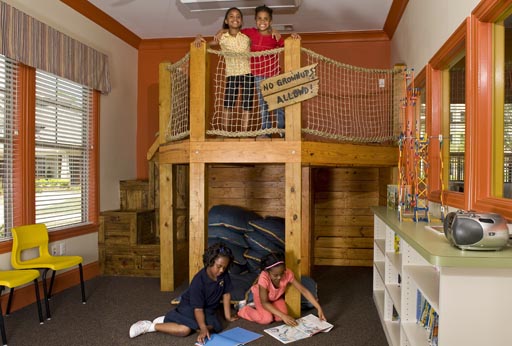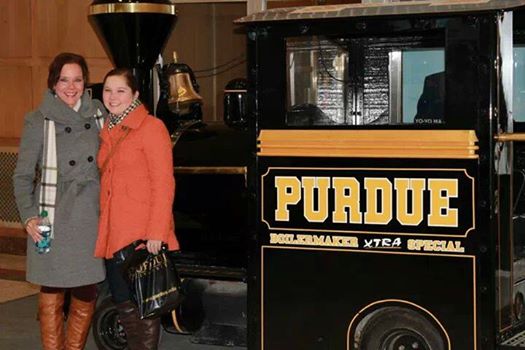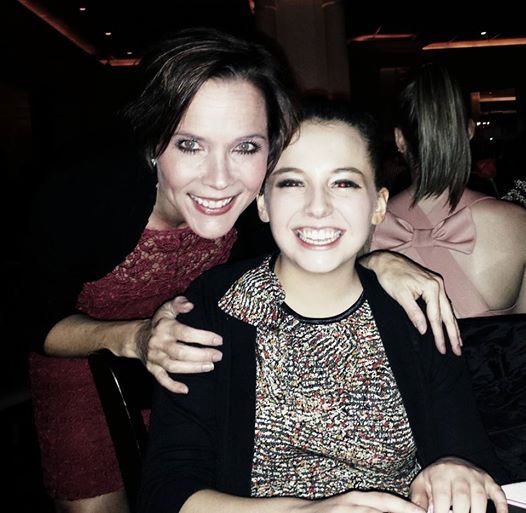by Georgia Center for Opportunity | May 27, 2014

Recently, I had the privilege of attending an inspiring seminar sponsored by Chick-fil-A Foundation and Gifted Education Foundation (a GCO partner), entitled “Beyond Inspiration: Moving Ideas to Execution”. As I walked into the Chick-fil-A Discovery Center to find my seat, my eyes wandered around the state of art facility, I was ready to experience the learning lab and to be inspired!
Charles Lee, CEO of Ideation and author of Good Idea. Now What? How to Move Ideas to Execution, was the speaker for the seminar. Charles helps businesses and organizations craft and facilitate amazing ideas via creative business design, branding and innovative problem-solving.
In his opening he stated, “The greatest collections of human treasures are in the graveyard. There are too many songs and too many books that have been buried.” With this image in my mind, a moment of sadness came over me for the people who did not have the opportunity to share their ideas with the world. Then, a smile broke through when I thought about all the possible ideas being executed in the filled room.
Mr. Lee focused on three areas: creating a remarkable idea, idea-making best practices and developing a remarkable brand. When creating a remarkable idea, ask clarifying questions so that our ideas can connect to the world. Ask questions such as Who are You?, What do you do uniquely? , and What does it matter? He informed that a few best practices are to write down your ideas (rational and irrational) in order to stay focused and to take time to breathe in order for your ideas to grow and develop. Mr. Lee encouraged us to develop brand attributes that are “authentically you”. Making sure your visual identity is consistent with your brand is the utmost important internally and externally. These are just some areas discussed during the seminar intended to help inspire us to better execute our ideas.
After the seminar, we were escorted on a tour of the Chick-fil-A’s 80,000 square foot innovation center. My colleagues and I were amazed by this huge warehouse that was designed to encourage people to think outside the box. The space was colorful with an open office environment that celebrated creativity and service. In fact, red boxes climb the wall and hung onto the ceiling until the boxes eventually formed an airplane. This space was truly designed to nurture innovation.
One of my colleagues, Linda Newton, who also attended the event shared how her approach to work productivity was impacted by the workshop. She said, “I have a tendency to be a bit too social at work and often get distracted by others. Some points Charles made concerning productivity have led me to implement two practices that are helping me to be less distracted and more productive. I now only schedule meetings after lunch and I work with my office door closed each morning until lunchtime. These are two simple, yet effective tactics.”
For me, exhilarating and motivating are two words that come to mind when describing my experience at the Beyond Inspiration learning lab with Charles Lee and Chick-fil-A Innovation Center. As I think about the mission of GCO: to remove barriers to opportunity. The very nature of our education advocacy work comes to mind. We have been a strong voice in school choice by helping to expand academic options (i.e. tax credit scholarships, special needs scholarships, public school transfers, private schools and charter schools) for more than 15,000 children in Georgia. Through our grassroots outreach efforts we have trained more than 60 advocates on topics such as how to talk with a legislator, how to use social media, and blog writing and interviewing skills for media. Additionally, we created a School Choice Handbook to serves as a reference for anyone seeking school choice options. Though thousands of children have benefitted from our efforts, there are thousands of children who still need our help. Therefore, we will continue to be a champion for education reform and school choice options at the capitol and at a grassroots level.
As we continue to remove barriers, there is nothing more exhilarating and motivating to me than the goal of seeing all children in Georgia have the opportunity to receive a great education. My hope is for children to experience an environment where their innovation can be nurtured and they can be inspired just as I was in learning lab and in my work place.
by Georgia Center for Opportunity | May 23, 2014
Below is a guest blog by Mrs. Sheila Caldwell, Director for Complete College Georgia at the University of North Georgia. Mrs. Caldwell currently serves as a member of GCO’s College & Career Pathways working group.
************************
In a recent poll of high school seniors asking how many credit hours per semester they should take when they go to college; more than 50 percent indicated 12 hours as an ideal college course load. Though 12 hours is a full-time course load, it is impossible for a student to earn a bachelor’s degree within four years unless a student takes an additional six hours during the summer. The primary route to earning a bachelor’s degree within four years is to successfully complete 15 credit hours per semester, for a total of 30 credit hours annually.
To improve college graduation rates and encourage on-time completion, the state of Georgia has launched 15 to Finish, a proven advisement, retention, progression, and graduation initiative that encourages students to take 15 credits per semester, thereby spending less time and money to earn a degree. The goal of Complete College Georgia and 15 to Finish is to provide better information and educate all students on tuition and fees, graduation rates, and job opportunities to ensure successful college completion.
The 15 to Finish initiative is important because many students express a desire to graduate within four years. Colleges are referred to as either four-year or two-year institutions, but most students are taking longer to graduate. In fact, if 100 students entered college today in the state of Georgia, only 11 students would graduate on time at a four-year college and only five would graduate on time at a two-year college (Complete College America, 2011). Full time-students are taking an average of five years to earn a bachelor’s degree and four years to earn an associate degree (Complete College Georgia, 2011). Many students are unaware of the potential consequences that can result from taking fewer credit hours, including a higher likelihood of non-completion, lost wages, and increased college costs.
A cost analysis conducted by the University System of Georgia seeking to determine how much a student would pay for a degree based on the number of credit hours taken per semester revealed staggering results. For example, a student enrolled in a bachelor’s degree program at the University of North Georgia (UNG) would pay an average of $42,236 to earn a degree by completing only three credit hours per semester compared to $26,768 if completing 15 hours per semester– nearly $15,000 in savings for a UNG student who graduates on time. The study found the cost difference is even more drastic for students who wish to attend Georgia Tech or the University of Georgia (UGA). The chart below illustrates an additional expense of $74,000 for Georgia Tech and $90,000 for UGA for students taking only 3 hours per semester.
|
Credits/
Semester
|
GA Tech
|
UGA
|
|
3
|
$119,474.00
|
$134,357.00
|
|
6
|
$75,914.00
|
$73,317.00
|
|
9
|
$72,875.00
|
$70,205.00
|
|
12
|
$56,164.00
|
$54,587.00
|
|
15
|
$45,514.00
|
$44,325.00
|

Not only do students reap significant financial benefits when they enroll in 15 hours every semester until degree completion, they also experience quicker entry and higher wages when they transition into the workforce. Students graduating from UNG with a bachelor’s degree earn an average of $20,000 more annually than their high school counterparts. A college student who graduates within four years with a bachelor’s degree earns $40,000 more in income than a college student who takes six years to graduate. Additionally, associate degree holders who graduate within 2 years earns $19,000 more than associate degree holders who take four years to graduate (Education Pays, 2013). Many part-time students do not consider the enormous amount of money foregone in the workforce when they delay college completion by one or two years.
Part-time students pay more for their degree and incur lost wages because they lack a college credential. They also jeopardize their entire college career. According to “Time is the Enemy” (CCA, 2011), only 15% of part-time students will earn a bachelor’s degree within six years compared to 57% of full-time students. Only 7.8% of associate degree seekers will earn a degree within four years. The 15 to Finish initiative seeks to battle dismal college completion rates.
College completion not only enhances an individual’s economic well-being, it can improve overall quality of life in the following ways: longer life spans, better access to health care, more prestigious employment and greater job satisfaction, less dependency on government assistance, greater participation in leisure, civic, and artistic activities, and more self- confidence (Education Pays, 2013).
Serving as a member of the College and Career Pathways working group, the Complete College Georgia (CCG) 15 to Finish initiative is perfectly aligned with recent discussions among the panel. The primary goals of the working group are to develop and promote programs that encourage at-risk youth to graduate high school and attain college and career success. GCO and CCG collaborate to help all students better prepare, connect to, and navigate college. Our ultimate aim is to enable greater mobility and opportunity among Georgia citizens.
*********************

Sheila Caldwell aims to help students successfully access and complete college at University of North Georgia. She is passionate about opportunity over charity and strives diligently to be a change agent for economically disadvantaged students across the state of Georgia.
by Georgia Center for Opportunity | May 23, 2014
 Georgia Center for Opportunity’s mission to remove barriers to opportunity is greatly facilitated through partnerships with organizations engaged in dynamic work in the community. Over the month of May the Breakthrough Fellows and GCO team members have ventured out, meeting with non-profits that serve unique at-risk populations. On one such trip, we were fortunate to speak with Jenn McEwen about her work at Wellspring Living, an organization dedicated to sheltering and restoring victims of sex trafficking.
Georgia Center for Opportunity’s mission to remove barriers to opportunity is greatly facilitated through partnerships with organizations engaged in dynamic work in the community. Over the month of May the Breakthrough Fellows and GCO team members have ventured out, meeting with non-profits that serve unique at-risk populations. On one such trip, we were fortunate to speak with Jenn McEwen about her work at Wellspring Living, an organization dedicated to sheltering and restoring victims of sex trafficking.
Tucked away just outside of Atlanta’s city limits, Wellspring’s secluded campus creates a warm environment for its residents. Close to one hundred minors and adult survivors participate in the Wellspring Living for Girls and Empowered Living for Women programs. Services through both programs range from intensive one-on-one therapy for Domestic Minor Sex Trafficking (DMST) to job skills training. The women of Wellspring, who are almost all referred by the state-run organization Georgia Cares, generally stay up to eighteen months. However, additional time is provided where it is needed.
Our host, Ms. McEwen, noted that girls are often lured into the sex trade by pimps selling the fantasy of love, capitalizing on disruptive home lives, or through physical coercion. While many would still like to believe that sex trafficking is an issue confined to areas such as Southeast Asia, major American cities are now thriving hubs for illegal sex work and exploitation. Nationally, as many as 27 million people are victims of sexual exploitation, with a vast majority being children. In a town known for its glorified strip club culture, Atlanta’s underground sex industry generated more than $290 million in 2007. This figure is likely much higher now. More recent studies note that the average pimp in Atlanta makes over $30,000 a week.
In Georgia, much work remains to change policies that criminalize the victims of sex trafficking rather than the perpetrators who reinforce commercialized sex. Just last year, the city of Atlanta proposed to banish convicted prostitutes, pimps, and Johns, which would make it illegal for offenders to enter areas with high rates of prostitution. However, this city ordinance, referred to as Stay Out of Area-Prostitution (SOAP), was never successfully passed due concerns that such as measure would further disadvantage the exploited.
As prostitutes are arrested at higher and disproportionate rates to pimps and Johns, more intentional policies are needed that target both the supply and demand sides of sex trafficking. In San Francisco, CA and Knoxville, TN, convicted Johns are mandated to participate in classes that expose the truth about what happens to the exploited after services are rendered. These “John Schools”, as they are called, often include restorative justice elements where former sex workers run the one-day classes and share their stories.
One thing is for sure: more havens such as Wellspring Living are needed across the state of Georgia. Ms. McEwen shed light on the gaps in service and the resulting opportunities, both in policy and program delivery, that impact her work. Inter-agency collaborations and community partnerships remain an integral component to increasing the support available to the victims of sex trafficking. As family breakdown and limited access to quality education open the door for exploitation, we at GCO hope to establish a strong working relationship with Wellspring, creating new possibilities and better outcomes for victims.
by Georgia Center for Opportunity | May 20, 2014

Recently I had the privilege of visiting Walton Village, a beautiful apartment community located in Marietta, Georgia. I, along with other GCO team members, visited Walton Village as part of our Breakthrough Fellowship experience to get a taste of other organizations in the community who share a common vision for seeing families thrive.
Walton Village is part of a larger network of apartments in metro-Atlanta area and Augusta that are owned and managed by Walton Communities. This privately held company has a unique mission of developing real estate in a way that builds strong communities and improves the quality of life of its residents. In addition to providing exceptional housing at an affordable price, the community offers educational, cultural, and recreational programs tailored to the hobbies, interests, and needs of the people they serve.[i]
Taking a similar approach to many partners in Georgia Center for Opportunity’s Breakthrough Norcross collective impact initiative, Walton Communities seeks to align itself with non-profits, schools, and other partners to achieve positive outcomes for families in their community.
For instance, Walton Village partners with the non-profit, faith-based organization Parents With A Purpose to run their Adventure Center, which provides an after school enrichment program for primary school children in the neighborhood. The Adventure Center seeks to boost children’s love for reading by offering a fun environment where children can curl up with a book and let their imaginations run wild. One room even has a custom-built loft with a sign posted at the top that reads: “No Grown-Ups Allowed!” The program as a whole focuses on developing the children’s character and teaching them to take ownership of the place they’ve been given through keeping it neat and orderly.

One outcome that Walton Village has seen as a result of its educational efforts with the neighborhood children is improved test scores: One hundred percent of the elementary school children in Walton Village (who regularly participate in Adventure Center programs) were reported to have passed the state-based Criterion-Referenced Competency Test (CRCT). This is not only an important outcome for the local elementary school, as children from Walton Village comprise 40 percent of the school’s student body, but also a significant academic milestone in each student’s development.
One of the things I like best about Walton Village is the wide age range of residents the community attracts. The Legacy at Walton is specifically designed for senior living, while the other apartments are available for singles, couples, and families of all stages. Intentionally fostering an inter-generational community provides the opportunity for the younger and older residents to interact with and learn from each other. We learned of one woman in the community who volunteers her time in the children’s Adventure Center teaching the kids how to crochet. This opportunity allows her to pass on an enriching hobby that many children may never have learned, while allowing the children to invigorate her with the life and energy that they naturally bring.
Walton Village seeks to build authentic community by providing a platform for neighbors to help meet each other’s needs. The director of community relationships shared the story of a woman who, at a monthly social held for single-parents in the neighborhood, explained that her daughter would miss prom because she couldn’t afford to buy her a dress. Another resident, moved with compassion, spoke up and said that her daughter had an old dress that she could wear. Yet another at the dinner chimed-in and said that she was a seamstress and would be happy to make the necessary alterations. Still, another neighbor who was a hair-stylist spoke up and volunteered to arrange her hair. Before they knew it, these ladies had teamed up to help make the woman’s daughter – and their neighbor – feel beautiful on the night of her prom. The women were so proud to have been able to chip in to make this night special for her.

Another example of neighbors supporting one another can be seen in the way families have shared groceries with one another during times of financial need. Every two weeks, a food co-op run by Walton residents delivers an equivalent of $100 in groceries to families in Walton Village who have signed-up for this service. Some of the participating families, recognizing the needs of other neighbors who do not regularly benefit from this service, have been known to share the food that they received with families who are in a tight spot financially.
Walton Communities offers a great example of a for-profit company that seeks to eliminate the status quo by delivering needed services in an extraordinary way. They aren’t simply in the housing business – they are in the community-making business – and their efforts are changing the lives of the families living in their communities.
[i] Walton Communities Apartment Homes, “Our History: Walton Communities,” accessed May 6, 2014, https://www.waltoncommunities.com/about-us/walton-story.
by Georgia Center for Opportunity | May 9, 2014
It seems like only days ago I was holding my 18-year old daughter Blair as an infant, and my mother said, “It will go by so fast.” I couldn’t have imagined how right she was. It is unbelievable to me that Blair is about to graduate from high school and go off to college. The memories of being a mother in those early days are so sweet. It was a precious time. And all of the memories since then, good and bad, will always mean so much to me.

As I look back over the years of raising Blair and her sister Anna, the memories sometimes all run together as one large mosaic. There are so many little things that happened along the way that I just can’t remember, but wish I could. Some days I would do almost anything to have their sweet little pre-school faces back to kiss, just one more time. They were both so smiley, giggly and sweet. I did all I could to keep them as happy as possible. I wanted their lives to be filled with singing, laughing, hugging, and as little crying as possible.

Time moved on and began to speed up. Days, weeks and years were filled with school, dance, piano, cheerleading, gymnastics, voice lessons, church choir, doctor visits, dentist visits, more dance, and then, even more dance. There was driving, lots and lots of driving…so much driving. All along the way there were opportunities to teach them how to be the beautiful, intelligent, responsible young women that they are today. I took a lot of those opportunities, but lost a lot as well, probably because I was just plain tired. Fortunately, they had many other people in their lives to pick up the slack.

The teenage years began, and so did the tension. This is when instinct no longer did the trick. This is when many of the parenting mistakes occurred. This is when I screwed up a lot. This is when they realized I wasn’t so perfect, and sometimes even hated me. This is when I sometimes hated myself. This is when I found out what I was made of. This is when I learned what it really means to be a mother.

Now that they are 18 and 16, one leaving us soon, the other a new driver, I think about how this stage of my life is quickly coming to an end. They soon will both be off doing wonderful and exciting things. And, although it often hurts to think of them leaving, I know that I have done my job well and that they will be successful, and I pray, happy adults. What I have learned from this motherhood experience is that being a good mother requires you to accept your imperfections and admit to your mistakes, but also to enjoy the end product, your children, and know that YOU did it. Take the credit. Be proud of yourself, and be happy that you have invested yourself as a mother. I know I am.











